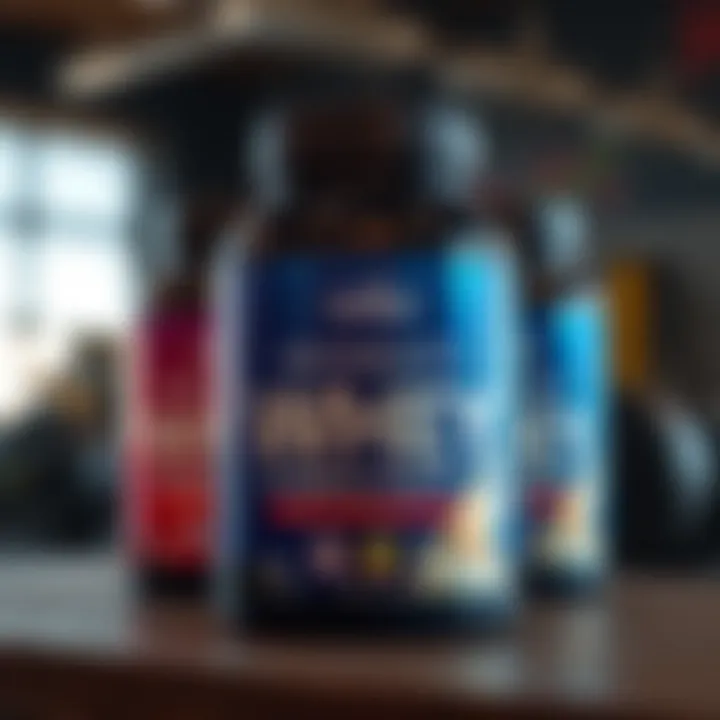A Complete Guide to Whey Hydrolysate Benefits


Intro
In the ever-evolving landscape of nutritional supplements, whey hydrolysate stands out as a powerful ally for those looking to enhance their muscle recovery, support overall health, and optimize performance. Unlike standard whey protein, whey hydrolysate undergoes a process called hydrolysis, breaking down proteins into smaller peptides for quicker absorption and assimilation in the body. This unique characteristic makes it particularly attractive to athletes, fitness enthusiasts, and health-conscious individuals alike.
As we explore the profound benefits of whey hydrolysate, it becomes clear that it offers more than just protein content; it’s about what this supplement can do for the body and mind. The aim here is to distill complex nutritional science into actionable insights that resonate with health professionals, wellness coaches, nutritionists, fitness trainers, and mindfulness instructors. This information is vital for those who guide others on their health journeys.
Through this article, we’ll highlight the diverse health benefits of whey hydrolysate, analyze its role in physical and mental well-being, and offer practical tips on integrating this supplement into daily routines. Thus, navigating the world of whey hydrolysate does not have to be daunting; with the right knowledge, anyone can make informed choices that align with their personal health and fitness goals. With that in mind, let's take a closer look at the health benefits it holds.
Health Benefits
Whey hydrolysate is not just another protein powder; its multitude of health benefits makes it a compelling choice for various lifestyle objectives. Specifically, we can categorize these benefits into physical and mental health advantages.
Physical Health Benefits
Protein is the building block of muscles and performs a crucial role in numerous bodily functions. Here are some notable benefits of whey hydrolysate on physical health:
- Enhanced Muscle Recovery: After an intense workout, muscle fibers endure micro-tears and require protein to repair. Hydrolyzed whey protein is absorbed quickly, providing amino acids when needed most.
- Weight Management: Protein has a satiating effect, which can help control hunger, ultimately leading to better weight management. Including whey hydrolysate in a balanced diet can assist those striving for fat loss or muscle gain.
- Boosted Immune Function: Some studies suggest that hydrolyzed whey protein can support immune health due to its potential to elevate levels of certain immune-boosting peptides in the body.
- Blood Sugar Control: Whey hydrolysate may aid in stabilizing blood sugar levels post-meal by slowing down glucose absorption, which is especially beneficial for those managing diabetes.
Mental Health Benefits
While much focus is placed on the physical aspects of protein, it’s worth considering its role in mental health too:
- Improved Mental Clarity: Amino acids found in whey hydrolysate can support neurotransmitter production, potentially enhancing focus and cognitive function. This is essential for those engaging in mentally demanding tasks or sports.
- Stress Reduction: There’s emerging evidence that adequate protein intake, particularly from whey, facilitates the production of serotonin, which may alleviate feelings of anxiety and stress, though more research is needed in this area.
- General Mood Enhancement: As a complete protein, whey hydrolysate can help in maintaining balanced energy levels throughout the day, potentially contributing to a more stable mood.
“Nutrition is not just about food; it's about understanding how a proper diet can lead to optimal health and wellness.”
In sum, the physical and mental health benefits of whey hydrolysate underscore its value as a versatile supplement, and this journey into its properties is just beginning. Next, we will delve into practical tips to best harness the advantages of this powerful protein source.
Understanding Whey Hydrolysate
Understanding whey hydrolysate is key to unlocking the potential benefits of this advanced form of protein supplement. In the world of fitness and nutrition, whey hydrolysate stands out due to its unique properties that cater to a myriad of lifestyle goals. For those eager to enhance their muscle recovery, this protein source plays a vital role. Its fast absorption rates make it particularly appealing for athletes and fitness enthusiasts looking to optimize their intake post-workout. Moreover, considering the effectiveness of dietary supplements, it's important to discern how whey hydrolysate differentiates itself from the more commonly known whey concentrate and isolate.
What is Whey Hydrolysate?
Whey hydrolysate is essentially whey protein that has undergone a hydrolysis process. This process involves breaking down protein into smaller peptides or amino acids, making it easier for the body to digest and absorb efficiently. Because of this, it’s often characterized as a pre-digested form of protein. This can be particularly beneficial for individuals with sensitive stomachs or those who may struggle with digestive issues linked to regular protein sources. Additionally, this method of processing typically reduces the allergenic properties of whey, making it a more suitable option for those who are lactose intolerant compared to other forms of whey.
The Hydrolysis Process
The hydrolysis process is where the magic happens. Proteins are large molecules composed of chains of amino acids, and during hydrolysis, these chains are broken down using enzymes or acidic conditions into smaller fragments. This transformation results in a product that provides quicker nutrient absorption. Consequently, whey hydrolysate can deliver amino acids to the muscles almost immediately after consumption, enhancing muscle repair and growth following intense exercise. The degree of hydrolysis can vary across different products, affecting the overall protein quality and absorption rate, hence, it’s crucial to select a product that specifies this information.
Comparison with Other Protein Types
When examining whey hydrolysate, it’s essential to put it into context with other protein varieties.
Whey Concentrate
Whey concentrate is the least processed form and contains around 70-80% protein content, along with some carbohydrates and fats. It is celebrated for its rich flavor and cost-effectiveness, making it a popular choice among casual consumers. However, due to its higher lactose content, it may not be suitable for those with lactose sensitivities. The key characteristic of whey concentrate is its balance of nutrients, which supports muscle synthesis efficiently but not as rapidly as whey hydrolysate.
Whey Isolate
Whey isolate, on the other hand, undergoes further processing than concentrate, generally providing about 90% protein at a higher purity. The reduction in fat and lactose content makes it appealing to those looking to maintain a low-carb diet or manage weight. Its characteristic feature is its quick dissolving ability, allowing for a smoother blend in shakes. While it offers better absorption than concentrate, it still doesn't match the speed of whey hydrolysate, making it slightly less favorable right after intense workouts.
Casein
Lastly, casein is a slow-digesting protein that releases amino acids gradually into the bloodstream. It's often utilized in meal timing strategies that favor overnight recovery. This distinctive feature means casein can keep you feeling full for longer, which can aid in weight management. Nonetheless, compared to whey hydrolysate, it does not provide the immediacy needed for muscle recovery post-exercise. The timing of protein digestion is therefore a crucial consideration if rapid muscle repair is the goal.
Overall, while whey hydrolysate excels in immediate absorption and ease of digestion, the other protein types offer unique benefits that might align more appropriately with different nutrition plans and goals. When navigating the selection of protein supplements, understanding these distinctions can guide users toward the most beneficial options.
Nutritional Profile of Whey Hydrolysate


Understanding the nutritional profile of whey hydrolysate is essential for anyone keen on maximizing their dietary protein intake. This form of protein stands out in terms of its amino acid content, digestibility, and health benefits that cater to a variety of audiences, from athletes to general health enthusiasts. By dissecting what makes whey hydrolysate unique, we can uncover how it can be integrated into daily routines effectively.
Amino Acid Composition
Whey hydrolysate provides a robust amino acid profile that sets it apart from other protein supplements. It contains all essential amino acids (EAAs) and is particularly high in branched-chain amino acids (BCAAs), which are crucial for muscle recovery and growth. Comprising amino acids like leucine, isoleucine, and valine, BCAAs play a vital role in stimulating protein synthesis. This composition isn't just a feather in its cap; it's why many athletes prefer it over others.
When we compare whey hydrolysate with whey concentrate or isolate, we notice that hydrolysate typically offers a higher percentage of free amino acids, making it more readily available for the body to utilize. This rapid absorption can give a quicker boost after workouts, which is beneficial for those looking to optimize their recovery time.
Digestibility and Absorption Rates
Another promising aspect of whey hydrolysate is its exceptional digestibility. Due to the hydrolysis process, the protein is broken down into smaller peptides, making it easier and faster for the body to absorb. This speedier digestion means that it can be particularly useful in post-exercise recovery. Research suggests that whey hydrolysate can be digested within minutes, allowing amino acids to flood into the bloodstream quickly.
This rapid absorption can be a game changer, especially after an intense workout, as it helps in minimizing muscle breakdown and kickstarting the repair process almost immediately. However, it’s worth noting that individual responses to protein absorption can vary; thus, some may experience different rates of digestion based on personal health conditions.
Potential Health Benefits
The potential health benefits of whey hydrolysate are numerous and varied. From muscle repair to immune support and weight management, each aspect can significantly contribute to overall health and performance.
Muscle Repair
Muscle repair is a non-negotiable part of any fitness journey. Whey hydrolysate is particularly effective here due to its rich concentration of amino acids that help repair muscle fibers post-exercise. Additionally, the fast absorption rate facilitates quicker recovery times, which is a standout feature for anyone engaged in high-intensity training regimens. The key characteristic that makes whey hydrolysate a top choice is its ability to minimize delayed onset muscle soreness (DOMS). By addressing micro-tears in muscle tissue promptly, it encourages athletes to resume their training with less downtime.
Immune Support
The immune system also stands to gain from incorporating whey hydrolysate into your diet. Containing immunoglobulins and lactoferrin, this supplement can aid in supporting immune function, making it a beneficial choice for those who train regularly. Regular intense exercise can leave the immune system somewhat compromised, so adding whey hydrolysate might bolster your defenses. The unique feature of whey hydrolysate is that it provides not just a protein source but also components that can help your body resist illnesses.
Weight Management
For those focusing on weight management, whey hydrolysate offers another benefit. Its high protein content can lead to increased satiety, which helps in curbing unnecessary snacking and overeating. Additionally, the quick digestibility can make it an effective meal replacement option when time is tight. Whey hydrolysate assists in preserving lean muscle mass while promoting fat loss, a key characteristic that makes it favorable among those on a calorie deficit. It is advantageous in that regard, allowing you to stick to your diet plan without sacrificing muscle.
In summary, the nutritional profile of whey hydrolysate is both impressive and diverse. Its amino acid composition, digestibility, and myriad health benefits make it a worthy consideration for anyone looking to enhance their diet and overall well-being. Integrating it wisely could lead to substantial improvements in both performance and health.
Whey Hydrolysate in Sports Nutrition
Whey hydrolysate occupies a significant role in the realm of sports nutrition, particularly among athletes and fitness enthusiasts. It offers a multitude of benefits that can support optimal performance, recovery, and overall health. When delving into its importance, one finds that its unique properties distinguish it from other forms of protein, making it a valuable addition to dietary protocols aimed at enhancing athletic capability and resilience.
Role in Muscle Recovery
Muscle recovery is a pivotal concern for anyone engaged in physical activity. After intense workouts, muscles endure stress and damage that necessitate prompt repair and rebuilding. Whey hydrolysate is particularly beneficial in this regard. The hydrolysis process breaks down protein into smaller peptides, allowing for quicker absorption in the digestive tract. Consequently, this rapid absorption helps deliver amino acids to muscle tissue more efficiently, promoting recovery after strenuous exercise.
Moreover, research has consistently shown that consuming whey hydrolysate immediately following workouts can help reduce muscle soreness and speed up the recovery process. One study found that athletes who consumed whey hydrolysate reported lower levels of inflammation and fatigue compared to those who did not. Thus, it's essential for athletes to consider incorporating whey hydrolysate into their post-workout nutrition strategy.
Effect on Athletic Performance
When it comes to athletic performance, the implications of using whey hydrolysate are substantial. By facilitating muscle recovery, it inherently allows athletes to engage in training sessions with reduced downtime. But that’s not all—whey hydrolysate also helps in optimizing muscle protein synthesis. This is crucial for athletes looking to gain muscle mass or increase strength.
In addition, the amino acid profile of whey hydrolysate supports various metabolic functions that are vital during performance. For example, branched-chain amino acids (BCAAs) in whey hydrolysate can diminish fatigue during extended exercise sessions. Notably, athletes report improved endurance and capacity for high-intensity activities when incorporating this protein type into their regimen.
In a nutshell, whey hydrolysate serves dual purposes in sports nutrition: supporting muscle recovery and enhancing athletic performance.
In summary, the inclusion of whey hydrolysate in sports nutrition is not just a passing trend; it represents a scientifically backed approach to optimizing health and performance. With its unique properties, it stands out as an essential tool for anyone serious about their athletic endeavors.
Selecting High-Quality Whey Hydrolysate
Selecting a high-quality whey hydrolysate is crucial for anyone looking to enhance their nutritional intake, especially those focused on fitness and muscle recovery. The right choice not only ensures optimal performance but also contributes to overall health. A good product can help users meet their dietary needs more effectively and may even play a role in achieving specific health goals. When delving into the realm of whey hydrolysate, keeping an eye on the finer details can make a substantial difference between benefitting from this supplement and none at all. Knowing what to look for can save you a good bit of time, and perhaps even money.
Key Factors to Consider
Source of Whey


When we talk about the source of whey, we're referring to where the protein originates. The most common sources are either milk from cows or goats. Cow's milk is the traditional option, but some individuals prefer whey derived from goat's milk for its natural digestibility.
The key characteristic of the source of whey is its protein content quality. Higher-quality sources often mean better amino acid profiles, which can significantly benefit muscle recovery and growth. What's more, if you favor grass-fed dairy farms, it often indicates that the cows are raised in more natural environments, leading to healthier milk and consequently, a better protein product.
A unique feature of animal sourcing is that it offers variable blends of fats and carbohydrates aside from the protein content, presenting the advantage of broader nutritional support. However, some users might face an issue if they are lactose intolerant or allergic to dairy, which limits the usability of certain whey types.
Processing Methods
Processing methods define how whey hydrolysate is made from its source. A common method includes ultrafiltration, which preserves the protein structure while reducing lactose and fat.
What stands out here is that processing method has a direct impact on the purity of the product. For instance, high-quality processing methods ensure that essential nutrients remain intact and that unwanted substances are filtered out. Additionally, hydrolysis is part of this process, breaking down peptides into smaller components, increasing absorption rates.
While this method offers clear advantages in terms of bioavailability, not all processing methods yield the same results. Some cheaper alternatives might rely on excessive heating or harsh chemicals, diminishing protein quality. Thus, opting for a product with transparency about its processing can make a difference in your experience.
Additives and Sweeteners
When selecting whey hydrolysate, don't forget to check the additives and sweeteners included. Many brands enhance their products with flavors or other ingredients to make consumption more pleasant.
The key characteristic of additives is that they can influence both taste and nutritional value. Sometimes companies add natural sweeteners like stevia or monk fruit, which can be beneficial, while others might include artificial sweeteners that some people prefer to avoid due to potential side effects. A good product should ideally keep additives to a minimum, retaining a focus on quality ingredients.
The unique feature of carefully chosen additives is that they can enhance the flavor without compromising nutritional integrity. However, be wary of products that contain long lists of ingredients or artificial flavors. They can often veer the product away from its primary health focus. Keeping an eye on labels is therefore essential to avoid unsuitable choices and to enjoy the benefits effectively.
Recommended Brands and Products
In the landscape of whey hydrolysate, certain brands have gained notoriety for their reliability and effectiveness. Names like Optimum Nutrition, Dymatize, and MyProtein frequently find favor among athletes and health enthusiasts.
These brands have established trust by maintaining high standards for sourcing and processing their whey. Choosing well-known products can be a safer bet, especially for newcomers in the dietary supplement arena. Nonetheless, it remains essential to read the labels and verify the specifics to ensure that you are buying a high-quality product that meets your individual health and fitness goals.
For those wanting to cut through the jargon, straightforward labels and ingredient lists are your best friends.
Incorporating Whey Hydrolysate into Your Diet
In the ever-evolving world of nutrition, understanding how to properly integrate whey hydrolysate into one’s diet is fundamental for maximizing its benefits. This advanced form of protein, boasting faster absorption and digestion, necessitates consideration of various factors to optimize usage. Incorporating whey hydrolysate not only supports muscle repair but also enhances overall wellness.
The Importance of Incorporation
When it comes to dietary protein, timing and method of consumption can make all the difference. Whey hydrolysate stands out for its potential to aid quick recovery post-exercise, but its applications extend into everyday eating habits. Having a well-thought-out approach ensures one can harness the full range of benefits to meet fitness goals while also promoting general health.
Optimal Timing and Dosage
The timing of whey hydrolysate consumption plays a crucial role in realizing its benefits. Many fitness enthusiasts advocate for a post-workout window of about 30 minutes to an hour as the optimal time to intake whey hydrolysate. This is because the body needs immediate nutrients for muscle recovery and growth.
- Dosage Recommendations
It's commonly suggested to consume around 20 to 30 grams of whey hydrolysate, depending on individual needs and body weight. Listening to one’s body is key, as needs can vary.
Recipe Ideas and Usage Tips
Incorporating whey hydrolysate into daily meals doesn’t have to be a challenge. Its versatility allows it to be used in several ways, making it a seamless addition to a variety of recipes that can suit different palates and meal plans.
Shakes and Smoothies
Shakes and smoothies are likely the most popular methods of incorporating whey hydrolysate. They are convenient, quick to prepare, and can be easily customized to fit taste preferences. Mixing whey hydrolysate with fruits, vegetables, or even nut butter can create a nutrient-packed snack or meal replacement.
- Key Characteristics
One standout feature is the ease of blending. Due to its hydrolyzed form, it dissolves quickly, leading to a smooth consistency. This makes it a favored choice among athletes and health-conscious individuals alike. - Advantages
The combination of whey hydrolysate with nutrient-dense ingredients means that users can enjoy a satisfying and delicious way to meet protein needs. However, it's essential to keep an eye on added sugars and calories, particularly in pre-made recipes or commercially available smoothies.
Baking Applications
Baking applications are also a unique avenue for utilizing whey hydrolysate. It can be incorporated into various baked goods such as muffins, pancakes, or protein bars, providing an additional protein boost without compromising taste and texture.
- Key Characteristics
One of the remarkable aspects of baking with whey hydrolysate is its ability to retain moisture and enhance the flavor profile of baked products. This makes it a trendy option for health-focused bakers. - Advantages
By creatively using whey hydrolysate in baking, individuals can craft snacks that are not only pleasing to the tastebuds but also beneficial in terms of protein content.
Snacking Options


Snacking doesn’t have to be synonymous with junk food. Integrating whey hydrolysate into healthy snacks can enhance nutritional value and satiate hunger. Protein balls made from whey hydrolysate mixed with oats, seeds, and natural sweeteners are a prime example.
- Key Characteristics
The convenience of protein-rich snacks keeps energy levels stabilized throughout the day, making them great for mid-afternoon slumps. - Advantages
This approach often leads to healthier cravings and reduces reliance on empty-calorie foods. Additionally, preparing snacks ahead of time can simplify the journey towards a balanced diet.
In summary, incorporating whey hydrolysate into one's diet is not just about protein intake; it embodies a holistic approach to nutrition that can enhance well-being and support fitness goals. The various methods such as utilizing it in shakes, baking, or as healthy snacks create an array of opportunities for individuals committed to improving their health and lifestyle.
Potential Drawbacks and Considerations
When diving into the world of whey hydrolysate, it's important to cast a discerning eye on potential drawbacks and considerations. No supplement is without its flaws or limitations. Understanding these can help you make an informed decision about whether this protein type is right for you. Specifically, two substantial concerns often arise: allergic reactions and lactose intolerance, along with cost factors that may affect your choices. Let's explore these aspects in detail.
Allergic Reactions and Lactose Intolerance
Whey hydrolysate tends to be touted as easier to digest owing to its pre-digested nature; however, this does not make it universally suitable for everyone. Some individuals may react negatively to it due to allergies. Whey, being derived from milk, can trigger severe responses in those with dairy allergies. Symptoms might include skin reactions, digestive distress, or even respiratory issues. If you're among those who have had issues with dairy in the past, you'd be wise to approach whey hydrolysate with caution.
Moreover, even for those not allergic, lactose intolerance is another point to grapple with. While the hydrolysis process can reduce lactose content, it doesn’t completely eliminate it. For the lactose intolerant, consuming whey hydrolysate could lead to uncomfortable symptoms like bloating, cramping, or diarrhea. If you suspect lactose sensitivity, a quick conversation with a healthcare professional can guide you in your decision-making.
It is essential to know your body. Testing with small amounts might help gauge your reaction before making a commitment.
Cost Factors
Cost is a significant consideration when evaluating whey hydrolysate. Unlike traditional protein powders, the advanced processing required to create hydrolysate typically comes at a premium. This raises a few essential questions: Is the higher price justified? What are you getting for your extra bucks?
High-quality whey hydrolysate may not be as economically feasible for everyday users. Those who consume protein supplements regularly might find that indulgence takes a toll on their wallet. Consequently, always look for products that deliver value without skimping on quality.
And let’s not forget; not all brands are created equal. Some may charge more simply based on marketing rather than the actual nutritional value. When weighing options, consider the following:
- Price per serving: Determine how much protein you get for each scoop.
- Ingredient list: Look out for added fillers or sugars that can increase cost but decrease value.
- User reviews: Feedback from other customers can often shine a light on whether the product delivers as promised.
By keeping these factors in mind, you’ll be better equipped to navigate the financial aspect of integrating whey hydrolysate into your regimen.
Scientific Research and Studies
Scientific research plays a key role in understanding whey hydrolysate and its potential benefits. This is not just another trend in the fitness industry; it is backed by considerable scientific inquiry. Studies that focus on whey hydrolysate provide invaluable insights into how this protein can be incorporated into dietary regimens and athletic training. As health professionals, wellness coaches, nutritionists, fitness trainers, and mindfulness instructors, understanding the research surrounding whey hydrolysate can inform advice for clients and enhance credibility in the field.
Recent Findings on Whey Hydrolysate
Recent studies have shown that whey hydrolysate is highly effective in promoting muscle recovery and enhancing athletic performance. For instance, a 2021 study published in the Journal of Sports Science highlighted that athletes who consumed whey hydrolysate within 30 minutes post-workout exhibited higher muscle protein synthesis compared to those consuming other protein forms. The hydrolyzed nature of whey makes it easier for the body to absorb, providing essential amino acids quickly. This rapid absorption is critical during the recovery phase, allowing the muscles to repair efficiently.
Moreover, evidence indicates that whey hydrolysate can contribute to reducing muscle soreness. A research conducted by L. M. Smith et al. in 2022 found that participants who ingested whey hydrolysate reported lower levels of delayed onset muscle soreness (DOMS) after intense exercise sessions. Such findings affirm the potential role of whey hydrolysate as a superior choice for athletes seeking swift recovery.
“The supplementation of whey hydrolysate not only aids in muscle recovery but also supports the maintenance of lean body mass during cutting phases.”
Long-term Effects on Health
When discussing long-term health effects, whey hydrolysate stands out not just in athletic performance but also in daily health maintenance. Some longitudinal studies have suggested that regular consumption of whey hydrolysate can have various health benefits. For example, participants in a study from Nutrition Journal experienced not only improvements in muscle mass but also better metabolic flexibility over a six-month period. Such adaptability is essential for metabolic health and weight maintenance.
Additionally, whey hydrolysate can positively influence immune function. Research shows that individuals who regularly include whey protein in their diets may experience enhanced immune responses. One research from the American Journal of Clinical Nutrition demonstrated that whey hydrolysate consumption led to a significant increase in glutathione levels, an important antioxidant that plays a role in protecting against oxidative stress.
Closure
As we wrap up our discussion on whey hydrolysate, it’s crucial to highlight the elements that make this protein source stand out. Myriad benefits have been noted, particularly its swift absorption rate, making it a favored choice for those looking to enhance muscle recovery and athletic performance. As health professionals and fitness enthusiasts, understanding these facets enables better recommendations when guiding clients towards nutritional choices tailored for their specific needs.
Summarizing Key Insights
- Whey Hydrolysate vs Other Proteins: While whey concentrate and isolate offer certain benefits, the hydrolysate's advanced processing grants it an edge in digestibility. This means quicker absorption, which can be inherently advantageous during critical recovery windows.
- Nutritional Profile: The amino acid profile is typically higher in terms of essential amino acids, particularly leucine, which plays a pivotal role in muscle synthesis. With the potential for enhanced muscle repair, it’s easy to see why many trainers incorporate it into athletes’ diets post-exercise.
- Considerations: However, it isn’t just a matter of benefits. Factors such as tolerability, potential allergic reactions, and price sensitivity must be discussed openly. This helps in creating a balanced perspective on its advantages and disadvantages.
"Optimal nutrition requires a keen understanding not just of the nutrients themselves, but also of how they fit within an individual’s overall lifestyle and health goals."
Final Thoughts on Integrating Whey Hydrolysate into a Healthier Lifestyle
Incorporating whey hydrolysate into one's diet may indeed foster significant health benefits, but it’s not a silver bullet. It works best as part of a comprehensive nutrition plan that includes diverse protein sources, whole foods, and adequate hydration.
For those guiding clients or considering their own dietary changes:
- Timing: Ideal consumption often coincides with training sessions or as a convenient snack post-workout.
- Utilization: There’s a wealth of possible recipes, from protein shakes to energy bars, that can make inclusion easy and enjoyable.















